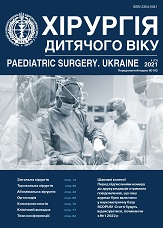Evolution of methods of surgical correction of pectus excavatum in children: single center experience
DOI:
https://doi.org/10.15574/PS.2021.73.38Keywords:
pectus excavatum, chest deformity, Nuss operation, surgery, pediatrics, thoracoplasty, resultsAbstract
Pectus excavatum (PE) in children is the most common pathology among orthopedic diseases of the anterior chest wall. Today in the world the main direction of scientific research in the surgical correction of this pathology is safety during surgery for the patient and the introduction of minimally invasive techniques.
Purpose – to conduct a comparative analysis of the results of thoracoplasty in children with PE using different surgical techniques to reduce trauma and duration of surgery and blood loss; to study the optimal correction results to accelerate psycho-physical adaptation after the Nuss procedure.
Materials and methods. The treatment of 289 patients operated on for PE in the orthopedic and traumatology department of National Children’s Specialized Hospital «OKHMATDYT» were analyzed. According to the methods of thoracoplasty used, patients were divided into 3 groups. In the first group (n=112) PE correction was performed using Nuss operation with subxiphoid access and tactile control during the retrosternal bar placement; in the second group (n=79) Nuss procedure was performed under thoracoscopic control, where one retrosternal T-shaped bar with additional lateral stabilizer was implanted and fixed on the ribs with a resorbable suture or wire; in the third group (n=98) surgical treatment of PE was performed using the Nuss procedure under thoracoscopic control using a fixator consisting of two retrosternal bars-arches, which are interconnected by lateral bars, the «Bridge» technique.
Results. When using thoracoscopic control and temporary sternum elevation by modificated «Park crane» during the correction of PE, the time of surgery and blood loss was reduced. No rotations of the fixator throughout the observation period and lower postoperative pain syndrome were observed in patients of the 3rd group, who underwent corrections with the «Bridge technique».
Conclusions. The technique of minimally invasive correction of pectus excavatum (MIRPE), Nuss operation, using thoracoscopic control and temporary elevation of the sternum during pectus bar placement is a safe and effective method of thoracoplasty. The use of two plates (the «Bridge» system) during minimally invasive correction is the operation of choice for adolescent children with funnel chest deformities.
The research was carried out in accordance with the principles of the Helsinki declaration. The study protocol was approved by the Local ethics committee of all participating institution. The informed consent of the patient was obtained for conducting the studies.
No conflict of interest was declared by the authors.
References
Chao CJ, Jaroszewski DE, Kumar PN et al. (2015). Surgical repair of pectus excavatum relieves right heart chamber compression and improves cardiac output in adult patients - An intraoperative transesophageal echocardiographic study. American Journal of Surgery. Elsevier Inc. 210: 1118-1125. https://doi.org/10.1016/j.amjsurg.2015.07.006; PMid:26499055
Choi S, Park HJ. (2017). Complications after pectus excavatum repair using pectus bars in adolescents and adults: risk comparisons between age and technique groups. Interact Cardiovasc Thorac Surg. 25 (4): 606-612. https://doi.org/10.1093/icvts/ivx162; PMid:28962496
Choi S, Park HJ. (2017). Complications after pectus excavatum repair using pectus bars in adolescents and adults: Risk comparisons between age and technique groups. Interact Cardiovasc Thorac Surg. 25 (4): 606-612. https://doi.org/10.1093/icvts/ivx162; PMid:28962496
Cierpikowski P, Rzechonek A, Błasiak P, Lisowska H, Pniewski G, Le Pivert P. (2018). Surgical correction of pectus excavatum by the nuss procedure: A 15-year experience study. Advances in Experimental Medicine and Biology. Springer New York LLC. 1047: 31-40. https://doi.org/10.1007/5584_2017_121; PMid:29525894
de Campos JRM, Tedde ML. (2016). Management of deep pectus excavatum (DPE). Ann Cardiothorac Surg. 5 (5): 476-484. https://doi.org/10.21037/acs.2016.09.02; PMid:27747181 PMCid:PMC5056944
Jaroszewski DE, Ewais MAM, Chao CJ et al. (2016). Success of Minimally Invasive Pectus Excavatum Procedures (Modified Nuss) in Adult Patients (≥30 Years). Ann Thorac Surg. 102 (3): 993-1003. https://doi.org/10.1016/j.athoracsur.2016.03.105; PMid:27283111
Jaroszewski DE, Velazco CS. (2018). Minimally Invasive Pectus Excavatum Repair (MIRPE). Oper Tech Thorac Cardiovasc Surg. 23 (4): 198-215. https://doi.org/10.1053/j.optechstcvs.2019.05.003
Kajzer A, Kajzer W, Gzik-Zroska B et al. (2018). Chest Wall Deformities. Ann Thorac Surg. 5 (4): 606-612. https://doi.org/10.1093/icvts/ivx162; PMid:28962496
Kryvchenia DIu, Prytula VP, Kuzyk AS. (2011). Varianty modyfikatsii operatsii Nuss v korektsii liikopodibnoi deformatsii hrudnoi klitky: perevahy ta nedoliky. Khirurhiia dytiachoho viku. 1: 27-30.
Monti L, Montini O, Voulaz E et al. (2019). Cardiovascular magnetic resonance assessment of biventricular changes during vacuum bell correction of pectus excavatum. J Thorac Dis. 11 (12): 5398-5406. https://doi.org/10.21037/jtd.2019.12.41; PMid:32030258 PMCid:PMC6988083
Nuss D, Kelly RE, Croitoru DP, Katz ME. (1998). A 10-year review of a minimally invasive technique for the correction of pectus excavatum. J Pediatr Surg. 33 (4): 545-552. https://doi.org/10.1016/S0022-3468(98)90314-1
Nuss D, Obermeyer RJ, Kelly RE. (2016). Nuss bar procedure: Past, present and future. Ann Cardiothorac Surg. 5 (5): 422-433. https://doi.org/10.21037/acs.2016.08.05; PMid:27747175 PMCid:PMC5056934
Razumovsky AY, Alkhasov AB, Razin MP et al. (2018). Comparative characteristics of the efficiency of different methods of operational treatment for pectus excavatum in children: A multicenter study. Pediatr Traumatol Orthop Reconstr Surg. 6 (1): 5-13. https://doi.org/10.17816/PTORS615-13
Tedde ML, de Campos JRM, Das-Neves-Pereira JC, Abrao FC, Jatene FB. (2011). The search for stability: Bar displacement in three series of pectus excavatum patients treated with the Nuss technique. Clinics. 66 (10): 1743-1746. https://doi.org/10.1590/S1807-59322011001000012; PMid:22012046 PMCid:PMC3180147
Downloads
Published
Issue
Section
License
The policy of the Journal “PAEDIATRIC SURGERY. UKRAINE” is compatible with the vast majority of funders' of open access and self-archiving policies. The journal provides immediate open access route being convinced that everyone – not only scientists - can benefit from research results, and publishes articles exclusively under open access distribution, with a Creative Commons Attribution-Noncommercial 4.0 international license(СС BY-NC).
Authors transfer the copyright to the Journal “PAEDIATRIC SURGERY.UKRAINE” when the manuscript is accepted for publication. Authors declare that this manuscript has not been published nor is under simultaneous consideration for publication elsewhere. After publication, the articles become freely available on-line to the public.
Readers have the right to use, distribute, and reproduce articles in any medium, provided the articles and the journal are properly cited.
The use of published materials for commercial purposes is strongly prohibited.

